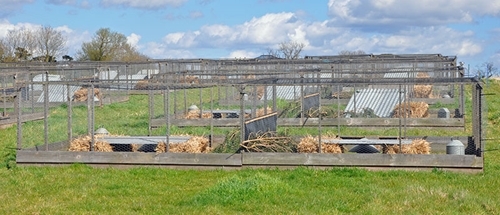Pens
 The standard pen consists of four 10-foot (3.3 metre) sections made of chicken wire and covered with a net. However, for better nesting results use a 10x20-foot pen as discussed further below. Each section should have a board approximately one foot (33cm) wide along the bottom to reduce feather damage, limit the birds’ view and prevent chicks from being lost through the wire mesh. Make sure that there are no holes and gaps. Any projection (nails, loose wire) must be removed to avoid damaging the birds.
The standard pen consists of four 10-foot (3.3 metre) sections made of chicken wire and covered with a net. However, for better nesting results use a 10x20-foot pen as discussed further below. Each section should have a board approximately one foot (33cm) wide along the bottom to reduce feather damage, limit the birds’ view and prevent chicks from being lost through the wire mesh. Make sure that there are no holes and gaps. Any projection (nails, loose wire) must be removed to avoid damaging the birds.- Pen sections should be placed onto a one-foot-wide membrane strip (e.g. damp-proof membrane) to help prevent the birds digging around the edge of the pen.

- Each bird must have sufficient access to food, clean water, grit and shelter from wind and rain at all times (a one-foot-deep board along one side of the pen and one foot off the ground will provide both shelter and a view point). The pen should also include brashings (deciduous and conifer) and areas of longer grass for cover and nesting and some grit (e.g. builders’ sharp sand).
- An electric fence around the pen(s) will help to prevent predation by foxes. Bait boxes and tunnel traps should be sited around the pen to keep rats, stoats and weasels at bay.
Food
- Chicks during the first two weeks of age should be fed commercial partridge crumb rations.
- Poults: feed the same as chicks, but with increasing amounts of a ground feed mixture (ie. mix of wild seeds, topped with pellets/crumbs).
- Adults: ground feed or a pellet mixture and access to growing grass/herbs, which will allow adaptation to natural food. If the ground inside the pen becomes too worn, move the birds onto fresh ground.
- Use the same type of feeder to feed release stock as used for feeding ‘wild’ birds during the last few weeks before release, allowing the release stock to adapt.
Parasites
- Parasites (especially gapeworm and coccidiosis) can be the most frequent cause of death when rearing partridges. Chicks are especially vulnerable.
- Move pens every year onto fresh ground.
- Adults should be treated for worms at six-weekly intervals using a top dressing of Flubenvet Intermediate.
- At all times remain vigilant for gapes as it will kill young poults very quickly – gaping or snicking is easily overlooked, as birds (when disturbed) often mask symptoms. Watching birds from a distance with a good pair of binoculars is worthwhile.
- If signs of illness persist or you are uncertain as to the cause, seek a diagnosis from a veterinary surgeon.
- Prior to release treat all birds with Flubenvet Intermediate for seven days.
Behaviour
 Birds for release should be kept as wild as possible, as tame birds are very vulnerable to predation. Therefore, place pens at a quiet site out of view and visit them only as much as necessary. Ideally change food and water after dark.
Birds for release should be kept as wild as possible, as tame birds are very vulnerable to predation. Therefore, place pens at a quiet site out of view and visit them only as much as necessary. Ideally change food and water after dark.
Source of rearing stock
- Rearing stock should ideally be as closely related to wild birds as possible. Therefore, the best option would be to start breeding stock from wild eggs, collected from over-mown nests. If this is not an option, get stock from a reputable source and ask about their origin and pedigree. When rearing for release, keep stock as genetically diverse as possible. Ideally do not release offspring of the same pair in the same area more than once.
Get your FREE guide from the GWCT Advisory team
Simply enter your email address below to download your essential free guide.
 What's inside your FREE guide
What's inside your FREE guide
✓ Background to releasing
✓ Guidelines for grey partridge re-establishment
✓ Measures needed for re-establishment
✓ Tips and tricks - releasing
✓ Husbandry practices
✓ Tips and tricks - rearing for release
✓ Summary of IUCN guidelines on re-introductions
*You may change your mind any time. For more information, see our Privacy Policy.